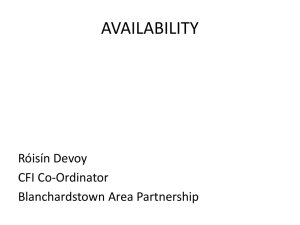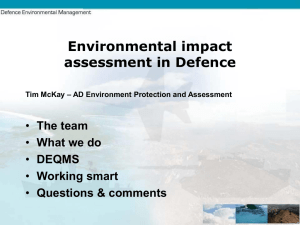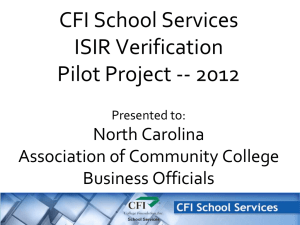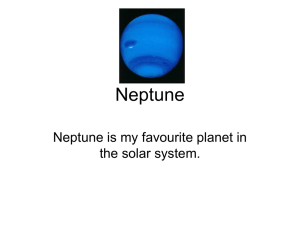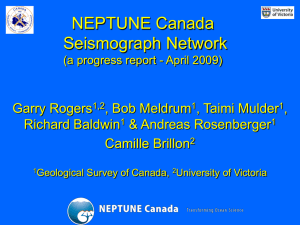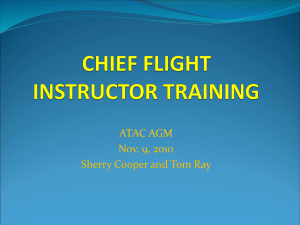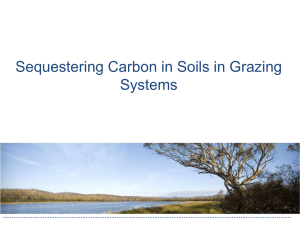NEPTUNE Canada Wiki
advertisement
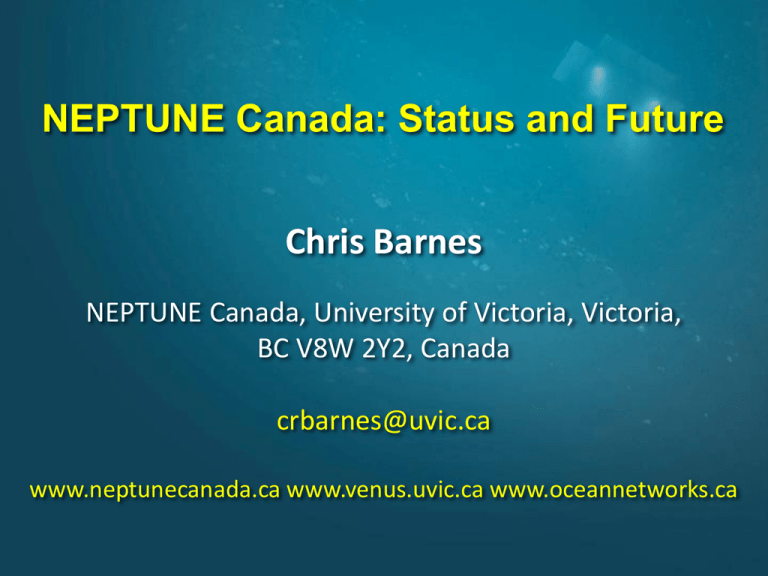
NEPTUNE Canada: Status and Future Chris Barnes NEPTUNE Canada, University of Victoria, Victoria, BC V8W 2Y2, Canada crbarnes@uvic.ca www.neptunecanada.ca www.venus.uvic.ca www.oceannetworks.ca Earth-ocean processes and systems 2 Transforming the ocean sciences NEPTUNE Canada: international collaboration and leadership • International collaboration: • With US through NSF/UVic MOU (now OOI/ONC MOU, 2010) • With US through OOI and IOs (Regional Science Nodes; Cyberinfrastructure) • Through MOUs with Ifremer, France (lead institute for ESONET), National Marine Institute, Ireland (Celtnet), Tongji Univ., China, JAMSTEC, Japan (DONET), agencies in Taiwan (MACHO), and Spanish observatories • Leadership position: • Building on smaller, coastal, specialized observatories (e.g. LEO 15, VENUS, MARS) • NEPTUNE Canada is the world’s first regional cabled observatory, being operational in late 2009; cf. DONET, MACHO, ESONET/EMSO, OOI - all likely to be operational in 3-7 years 3 Principal elements in building a regional cabled observatory: the last decade •Vision, articulation, concept •Science priorities, experiments •Ownership and liability •Funding proposals/O&M costs •Science requirements: engineering, DMAS •Engineering: network design, power and communications, wet plant, shore station, backhaul •Permits and Rights of Way •Route surveys, node sites, GIS •Operation/Data Centre •DMAS/Cyber: in-house development, evolving technologies, distributed databases, storage •Education and outreach •Special stakeholders: First Nations, fishers, navies •Communications: sci/public communities, media, partners •Partnerships: institutions, funders, foundations, internat. •Socio-economic benefits •Time, contingency, renewal, expansion costs NEPTUNE Canada Funding Awarded to Date Installation and Operating Funding awarded 2003-2012 Funding Source Canada Foundation Innovation BC Knowl. Development Fund Other Government Agencies University of Victoria In-kind support: Industry In-kind support: partner labs CFI/NSERC/BCKDF/CANARIE Oper. Total $M 39.9 38.5 3.1 2.0 17.0 4.5 38.2 143.2 Locations of scientific interest (RFP 262; 2005) NEPTUNE STAGES 1 & 2 Regional Scale Nodes, OOI Acquisition Plan Stage 1 Wet plant: Alcatel contract $39M, October 2005; 2-yr RFQ/RFP process Extensions and Secondary Nodes Route Surveys: ‘05 and ‘06 Science instruments: Agreements in Q1 ‘06 Shore Station: Port Alberni, purchased Sept ‘04 Backhaul (Shore Station to Victoria; CANARIE) DMAS and Observatory Control Internet access Power and the Internet into the oceans Nodes L3 MariPro and Alcatel-Lucent Networks seismic tsunami chemical current visual Major instrumentation Tethered Crawler 400m Vertical Profiler Jacobs Univ., Bremen, Germany Complex new technology developments NGK Ocean, Japan DMAS System: Overall Structure Benoît Pirenne, Victoria, Sep 29, 2009 Science Research Themes Plate tectonic processes and earthquake dynamics Dynamic processes of fluid fluxes and gas hydrates in the sea bed Regional ocean/climate dynamics and effects on marine biota Deep-sea ecosystem dynamics Engineering and computational research TEMPO-mini: for Endeavour vents • Designed by Ifremer (France) • An instrument module designed for study of hydrothermal vent communities • Video, temperature, oxygen, and iron sensors • Coordinated antifouling system All to same scale Wildlife Computer Mk10 PAT TOPP + POST = Popup Archival Transmitting Satellite Tag - TOPP Transition to Acoustic Archival Download (AAD) tags for the 21st Century A POST salmon smolt VEMCO R-code Acoustic Tags V9 - 2y program V9 - >4 mo life V7 - >4 mo life V6 - pre-production Lotek Geolocating Archival Tags Hybrid Acoustic/Archival Tags remain small, but increase recapture rate Jackson et al. Mar. Freshwater Res. 2005 Integrated AAD tags could download a salmon’s entire life history to POST/OTN curtains on spawning migration without recapture! NEPTUNE Canada: Governance and Management • Management structure in applications approved with funding awards from CFI, BCKDF and NSERC, with external reviews • ONC established in 2007 with Board of Directors and Executive Council: overall management of NC, VENUS, ONCCEE • ONCCEE established by $13.2M CECR award to ONC in 2008 • CFI Governance and Management Review of ONC and NC in 2008-09 by external consultants – (c. 250p. report to CFI; few issues) • NC also reports to the UVic VPs Research and Finance and Administration and through them to the Board of Governors (reports made at each meeting) • NC: Executive Committee, Science Advisory Committee, DMAS Advisory Committee, Cybersecurity Committee; under review in now moving into operating phase NEPTUNE Canada: possible future expansion options – CFI factors Overall Performance Evaluation and Value-for-Money Audit of the CFI As part of its Funding Agreement with the Government of Canada, the CFI must carry out an overall performance evaluation of its activities at least every five years, as well as a value-for-money audit. This requirement was completed and submitted to Industry Canada for a March 31, 2010 deadline. The evaluation of the CFI was conducted by an independent third party (KPMG). It focused on the achievement of the CFI against its national objectives and addresses global questions regarding results, design and delivery, and relevance. The audit of the CFI, also conducted by an independent third party (KPMG), examined the management practices and processes in place to achieve the CFI national objectives and whether they are carried out efficiently, effectively and economically. The evaluation and audit were supplemented by an independent report by an International Review Panel (IRP). The IRP was tasked with overseeing a high quality, credible process that would deliver valuable information for accountability and management decision-making purposes. As part of its mandate, the IRP was asked to formulate overall conclusions and recommendations on the performance of the CFI NC: Expected requirements for refunding of operations (2012-) • • • • • • • • • • • • a long-term vision extending over the projected operating lives of the observatories, c. 10 yrs a set of strategies and implementation plan for realizing the vision and maximizing impacts a credible business plan for the re-funding period (c. 5 yrs) priorities for choosing where to put effort and funding describing operational policies including allocation of services, user fees, management of MOUs/contracts, Intellectual Property Policy, use for development and commercialization objectives describing efficient management to manage risks and to keep the facility on track and on budget. Management could include one or more Science Advisory Boards human resources operating the facility, HR policies communications plan providing a budget justifying the funding request a set of shorter term (c. 2 yrs) goals and targets to indicate whether the facility is performing as expected and if and where effort should be re-directed annual reviews of observatory performance, including any available indicators of impacts on research, Canadian business, highly qualified people and public policy science quality verified by international peer review NEPTUNE Canada: possible future expansion options – CFI opportunity Budget 2010 and future CFI competitions In the recent federal budget, the Government of Canada reiterated its ongoing commitment to support the CFI’s future activities, including one or more new competition(s) to be launched by December 2010. The CFI expects to soon finalize a funding agreement with the Government of Canada on the allocation of the $600 million from Budget 2009. We remain committed to making strategic investments in current and new infrastructure that promotes leading-edge research; fostering partnerships among universities, colleges and business researchers that encourage private-sector innovation; and ensuring that world-class research facilities in Canada maintain their global leadership role. Our next update will provide more details on CFI programs allocations and the proposed timelines of future competitions. NEPTUNE Canada: possible future expansion options - questions • How should a Canadian science megaproject evolve and maintain a competitive leadership position and provide a Return on Investment of public funds? • What scientific areas were deemed a priority but could not be funded in 2006 ($39M requested but only $13M available for experiments/instruments)? • What new areas of inquiry/technology have emerged since 2006? • Given the power and bandwidth capacity and installed infrastructure, what new developments can add scientific impact to this initial investment? • Given the observatory’s location, footprint and 5-6 nodes, what other ocean processes can be addressed by additional sensors/robotics? • Future funding sources include CFI, NSERC, WED, Government Departments, industry, foundations, etc • Anticipated new federal program for funding operations of Major Science Initiatives (MSIs) – hence our current two-year CFI award (2010-12; $19.3M) NEPTUNE Canada: possible future expansion options - examples Possible new developments/instrumentation/experiments for NC expansion (no order of priority): • Additional profiler(s) for water column studies (complementing VPS) • Additional broadband seismometers for plate-wide seismology studies • Daisy-chained extensions to reach to the Pacific and Explorer plates • Additional cameras (HD) for improved imagery and outreach activities • Add the node ($2.7M) to the Middle Valley TRF and add instruments planned earlier (c.$2-3M), connecting to CORKed boreholes • Enhanced instrumentation for ocean acidification studies • Connect coastal acoustic receiver lines from Folger for Ocean Tracking Network project • Add gliders, especially for shelf transects • Add AUVs with node docking capabilities for long-term deployments • ……Consideration of scientific impact and significance • ……Consideration of socio-economic benefits NEPTUNE Canada: policy applications & socio-economic benefits • Hazard mitigation/Public safety • Tsunami warning system (Emerg. Preparedness) • Earthquakes: urban power shutdown systems • Security and sovereignty; port security • Non-renewable resources • Gas hydrates as future energy resource/climate threat • Sensor networks for offshore drilling platforms • Renewable resources • Sustainable fisheries: water mass changes, nutrient fluxes, Ocean Tracking Network data • Ocean/climate change • Regional temperature changes at various depths • Regional hypoxia • Ocean acidification • Impacts of regional ocean/climate change An invitation to interact • • • • • • • In participating in the scientific experiments, robotics, technology developments and commercial opportunities Free real-time subsea data, imagery, video and HDTV: wiring the oceans - transformative science The oceans on-line: short-term events; longer-term trends; climate change effects; impacts on marine life Current leadership: coast-to-coast national facility Contact: neptune@uvic.ca Visit our updated website: www.neptunecanada.ca Also visit: www.venus.uvic.ca www.oceannetworks.ca www.onccee.ca
